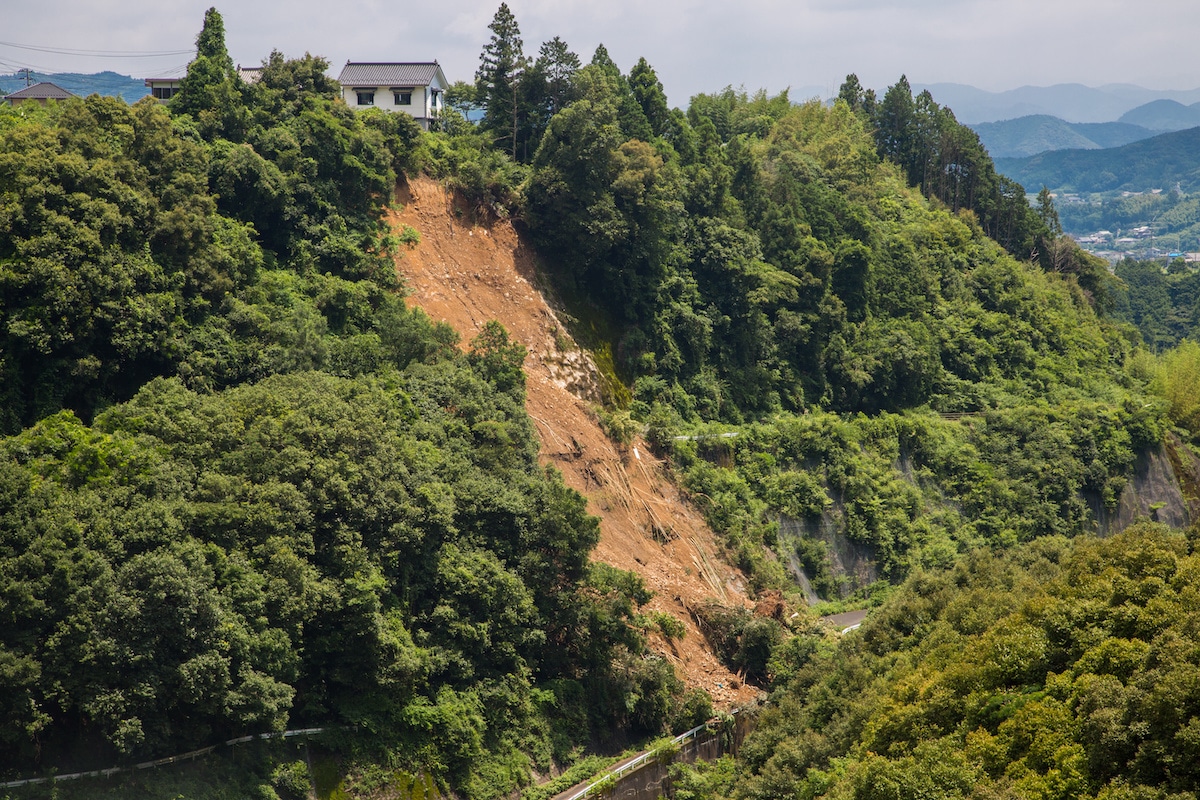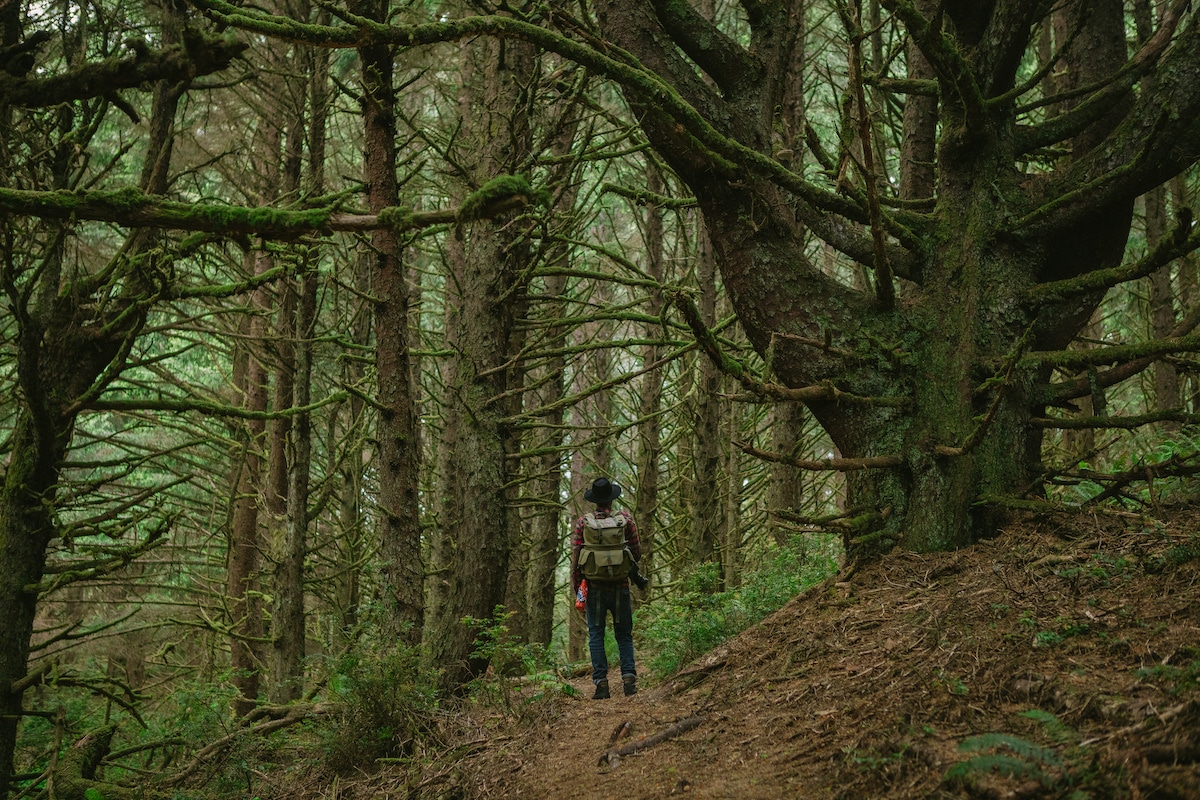Finding clean drinking water is often the biggest challenge when camping, hiking, or facing a survival situation. Contaminated water can carry dangerous pathogens, leaving you vulnerable to illness when you need strength the most. Thankfully, you don’t have to be a wilderness expert to learn how to purify water in the wild. In this article, you’ll discover proven methods, learn how to minimize risks, and gain confidence for your next outdoor adventure.
What We'll Cover
- Why Clean Water Matters
- Common Contaminants and Risks
- Factors Affecting Water Quality in the Wild
- Essential Methods for Purifying Water
- Tips for Collecting Water Safely
- Additional Considerations and Gear
- Best Practices to Stay Safe
- FAQs
- How long do I need to boil water at high altitudes?
- Is rainwater safe to drink?
- Can I filter saltwater with a regular camping filter?
- What if I only have time for one method?
- How important is taste in purified water?
- Conclusion
Why Clean Water Matters
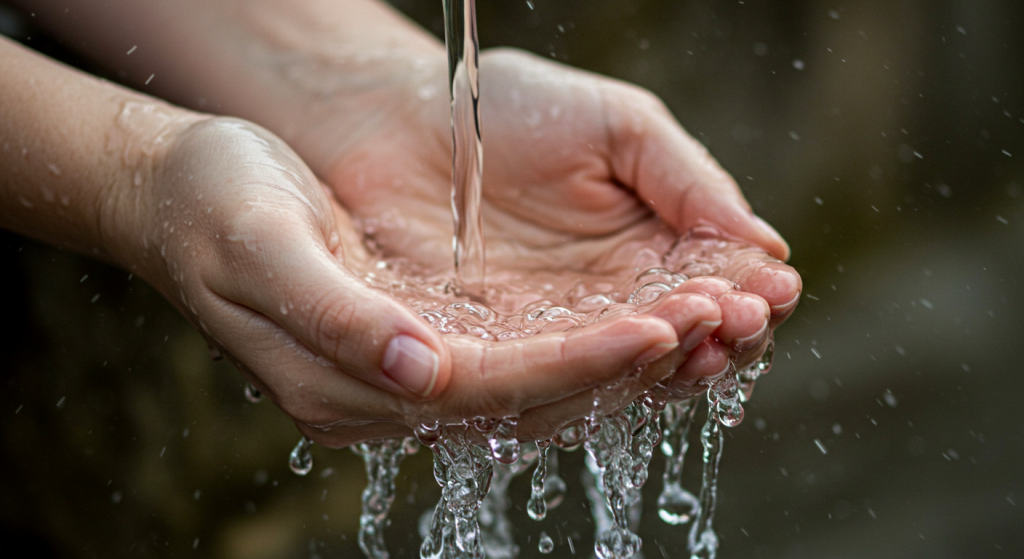
Water is vital for hydration, digestion, and basic bodily functions. Yet not all water in nature is safe to drink. Streams and lakes might look fresh, but they can still contain microscopic threats like viruses, bacteria, and parasites.
According to the Centers for Disease Control and Prevention (CDC), illnesses such as giardiasis and cryptosporidiosis are commonly contracted by drinking untreated water. These can lead to severe diarrhea, vomiting, and dehydration. Understanding water purification methods is essential for preventing such ailments.
Common Contaminants and Risks
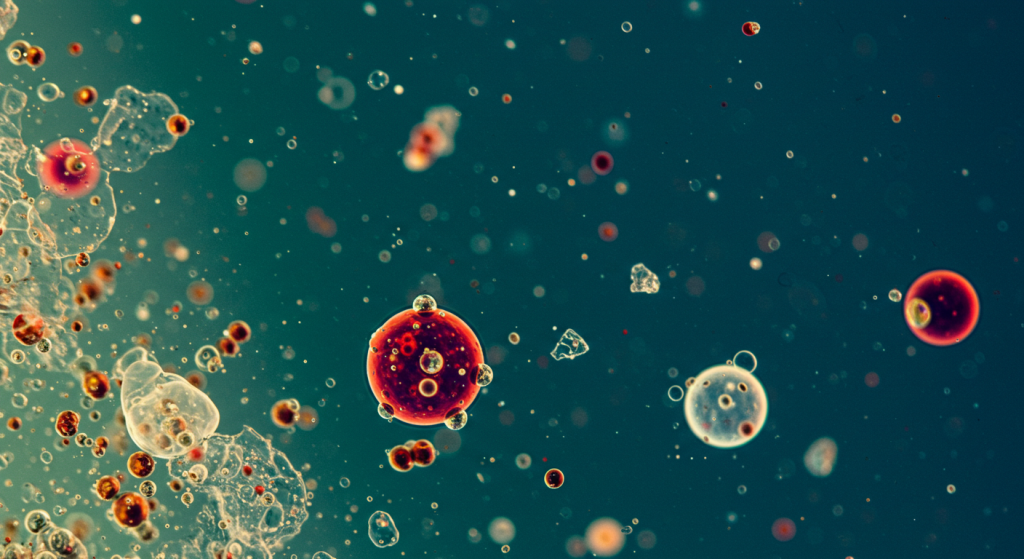
Bacteria and Viruses
Pathogenic bacteria (e.g., E. coli) and viruses (e.g., hepatitis A) are often too small to see. They can infiltrate water sources via animal waste, human activity, or environmental factors like flooding.
Protozoa and Parasites
Protozoa, such as Giardia lamblia and Cryptosporidium parvum, are prevalent in streams and lakes. They can remain dormant in cyst form, making them hardier than many bacterial contaminants.
Chemical Pollutants
Industrial runoff, agricultural chemicals, and heavy metals sometimes seep into rivers. Although less common in remote environments, it’s still important to be cautious if you’re near farmland or industrial zones.
Factors Affecting Water Quality in the Wild

- Location and Elevation: Higher elevations often have fewer pollutants. However, melting snow or glacial runoff may contain organisms that thrive in cold temperatures.
- Climate and Weather: Heavy rains can wash contaminants into streams. Prolonged droughts can concentrate pollutants in dwindling water holes.
- Animal Activity: Large populations of wildlife near a water source can contribute to higher concentrations of pathogens.
- Human Influence: Camping areas, mines, or farmland can introduce chemicals or waste, affecting your water safety.
Essential Methods for Purifying Water
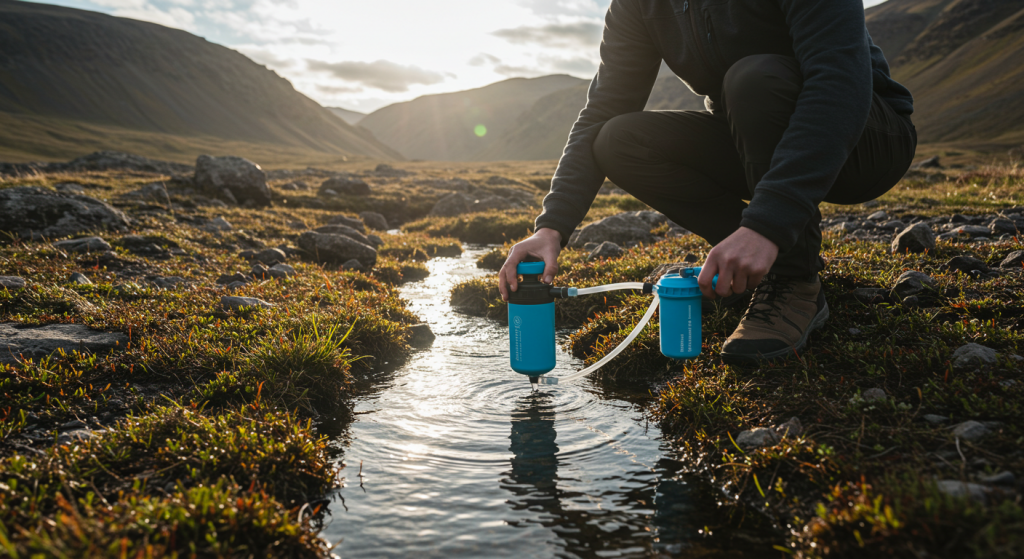
Below is an overview of the most common ways to purify water in the wild. Each method has its pros, cons, and best-use scenarios.
| Method | Equipment Needed | Time Required | Pros | Cons |
|---|---|---|---|---|
| Boiling | Heat source, pot or metal container | 5–10 minutes (plus cooling time) | Simple, kills most organisms effectively | Requires fuel source, time-consuming, no chemical removal |
| Filtration | Portable water filter or homemade filter | Immediate (flow-dependent) | Removes sediment and pathogens, convenient | Filter can clog or break; some viruses may pass |
| Chemical Disinfection | Water purification tablets or bleach | 30 minutes to 4 hours (varies) | Lightweight, kills bacteria and viruses | Wait time required; some parasites may be resistant |
| Solar Disinfection (SODIS) | Clear plastic bottle, sunlight | 6 hours in sunny conditions | Minimal gear, effective for bacteria and viruses | Requires strong sunlight, longer wait, limited volume |
| Distillation | Sealed pot, tube, secondary container | Several hours | Removes most contaminants, including chemicals | Complex setup, energy-intensive, time-consuming |
1. Boiling
Boiling is one of the oldest and most reliable methods for water purification. Simply bring water to a rolling boil for at least one minute at lower altitudes, and three minutes if you’re above 6,500 feet (2,000 meters). The heat kills most harmful organisms.
Pro Tip: If you have limited fuel, collect plenty of firewood and boil larger batches at once. Store extra boiled water in clean containers.
2. Filtration
Filtration units range from straw filters to pump-based systems. Many models remove bacteria and protozoa effectively. However, extremely small viruses may slip through some filters unless they’re designed to handle viral particles.
- Portable Filters: Handy for backpacking. Check product specs to ensure virus removal if you’re worried about viral contamination.
- Improvised Filters: Layer sand, gravel, and charcoal in a container with a small hole at the bottom. This DIY approach can remove sediment and some microorganisms, but you should still boil or chemically treat afterward for best results.
3. Chemical Disinfection
Chemical treatments like iodine tablets, chlorine dioxide tablets, or unscented household bleach can kill bacteria and most viruses. However, certain protozoa are highly chlorine-resistant and may require longer treatment times.
- Iodine: Typically adds a strong taste and is not recommended for pregnant women or those with thyroid issues.
- Chlorine Dioxide Tablets: Often used by hikers; follow the manufacturer’s instructions.
- Household Bleach: Ensure it’s unscented and has no added cleaners. For 1 quart (1 liter) of water, add 2 drops of bleach (5–6% chlorine). If the water is cloudy, double the dosage. Let it stand for at least 30 minutes before drinking.
4. Solar Disinfection (SODIS)
When you have clear plastic bottles and direct sunlight, solar disinfection can be effective. Fill a transparent bottle up to three-quarters full, shake to oxygenate, then top it off. Place the bottle in direct sunlight for at least six hours. UV rays will inactivate many pathogens.
Note: This method works best in regions with strong sunlight and clear skies. Murky or heavily contaminated water reduces efficiency.
5. Distillation
Distillation involves heating water until it vaporizes, then condensing the steam in a separate container. This removes nearly all pathogens and many chemical impurities. While highly effective, it can be time-consuming and requires a specialized setup. Distillation is most useful if you suspect chemical contamination or saltwater sources.
Tips for Collecting Water Safely
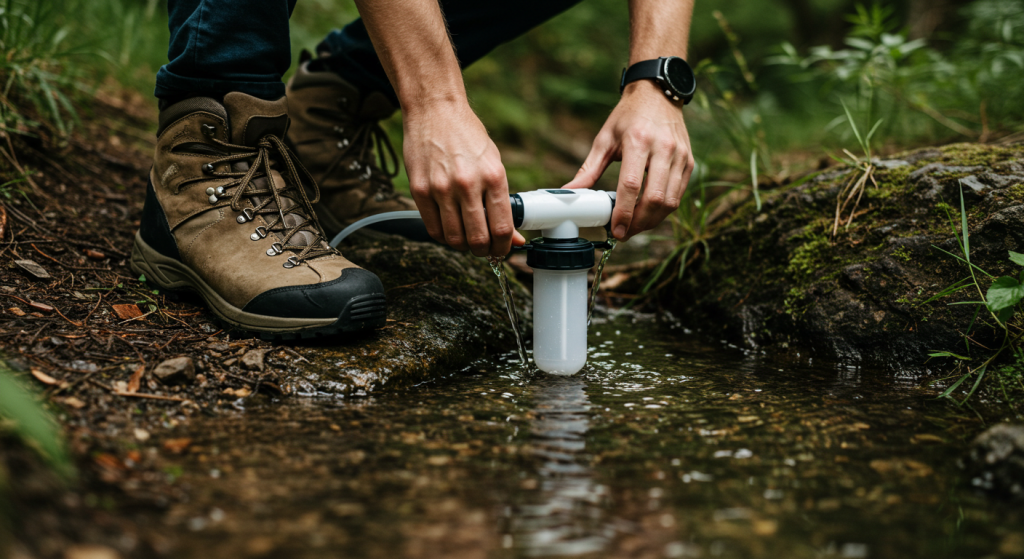
- Choose Fast-Flowing Sources: Look for clear, moving water in streams or rivers rather than stagnant pools.
- Avoid Obvious Contaminants: Stay upstream from campsites, farms, or industrial areas.
- Use Cloth or Bandana Pre-Filtration: Strain out sediment before you boil or chemically treat the water. This simple step can improve taste and reduce clogging in filters.
- Check for Animal Signs: If you see droppings or a large number of tracks along a shore, assume higher levels of contamination.
Additional Considerations and Gear
- Emergency Kits: Pack water purification tablets or drops in your first-aid kit. They’re lightweight and can be a lifesaver.
- Backup Container: A spare water bottle or collapsible container helps you store extra purified water.
- Test Your Gear: Practice with your filtration device at home. For maintenance tips on camping gear.

WaterBrick Long Term Water Storage: The WaterBrick STD storage containers have a 3.5 Gallon water holding capacity and take up a minimal amount of space, measuring just 9" W x 18" L x 6" H. Each cu...
Best Practices to Stay Safe
- Plan Ahead: Research local water conditions before traveling.
- Boil or Filter Whenever Possible: For maximum safety, use a combination of filtration and boiling.
- Try Layered Approaches: If water is extremely questionable, use two methods: for instance, filter first, then chemically disinfect.
- Stay Hydrated: Don’t wait until you’re dehydrated. Safe water is crucial for preventing fatigue, confusion, and heat stroke.
FAQs
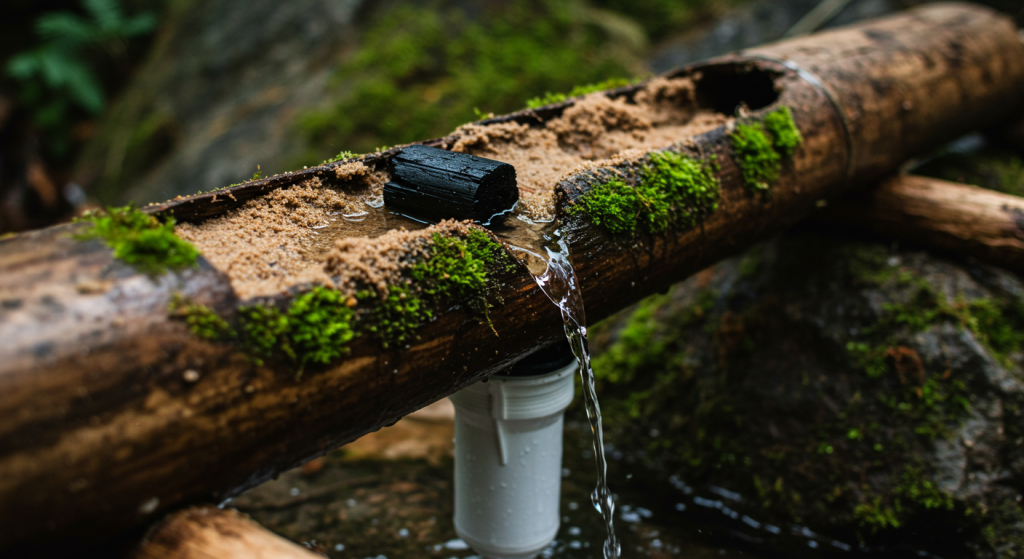
How long do I need to boil water at high altitudes?
As a general rule, boil for 3 minutes if you’re above 6,500 feet (2,000 meters). Higher elevations reduce the boiling point of water, so a longer boil helps kill organisms.
Is rainwater safe to drink?
Rainwater collected directly as it falls is usually cleaner than stagnant water. Still, contaminants can exist if the water runs off leaves or other surfaces. Consider using a filter or chemical treatment.
Can I filter saltwater with a regular camping filter?
No. Typical filters do not desalinate. You’d need a specialized desalination system or a distillation process to remove salt effectively.
What if I only have time for one method?
Boiling remains the most foolproof option. If you have limited time and fuel, a reputable filter is another quick solution—just be aware of viral contamination risks.
How important is taste in purified water?
Taste is secondary to safety, but you can improve flavor by aerating water (pouring it between clean containers) or adding electrolyte tablets. If a chemical taste persists, consider activated carbon filters.
Conclusion
Clean water is non-negotiable for your health, whether you’re on a weekend getaway or in a life-or-death survival scenario. By learning how to purify water in the wild—through boiling, filtration, chemical treatments, solar disinfection, or distillation—you drastically reduce your exposure to harmful pathogens.
Always remember:
- Opt for fast-flowing sources when possible.
- Layer purification methods for added peace of mind.
- Pack essential gear and chemicals before setting out.
A little preparation ensures you’ll stay hydrated and healthy, allowing you to fully enjoy the beauty of nature. The next time you venture into the backcountry, you’ll have the confidence and knowledge to secure safe drinking water—even in the most remote environments.
The responses below are not provided, commissioned, reviewed, approved, or otherwise endorsed by any financial entity or advertiser. It is not the advertiser’s responsibility to ensure all posts and/or questions are answered.
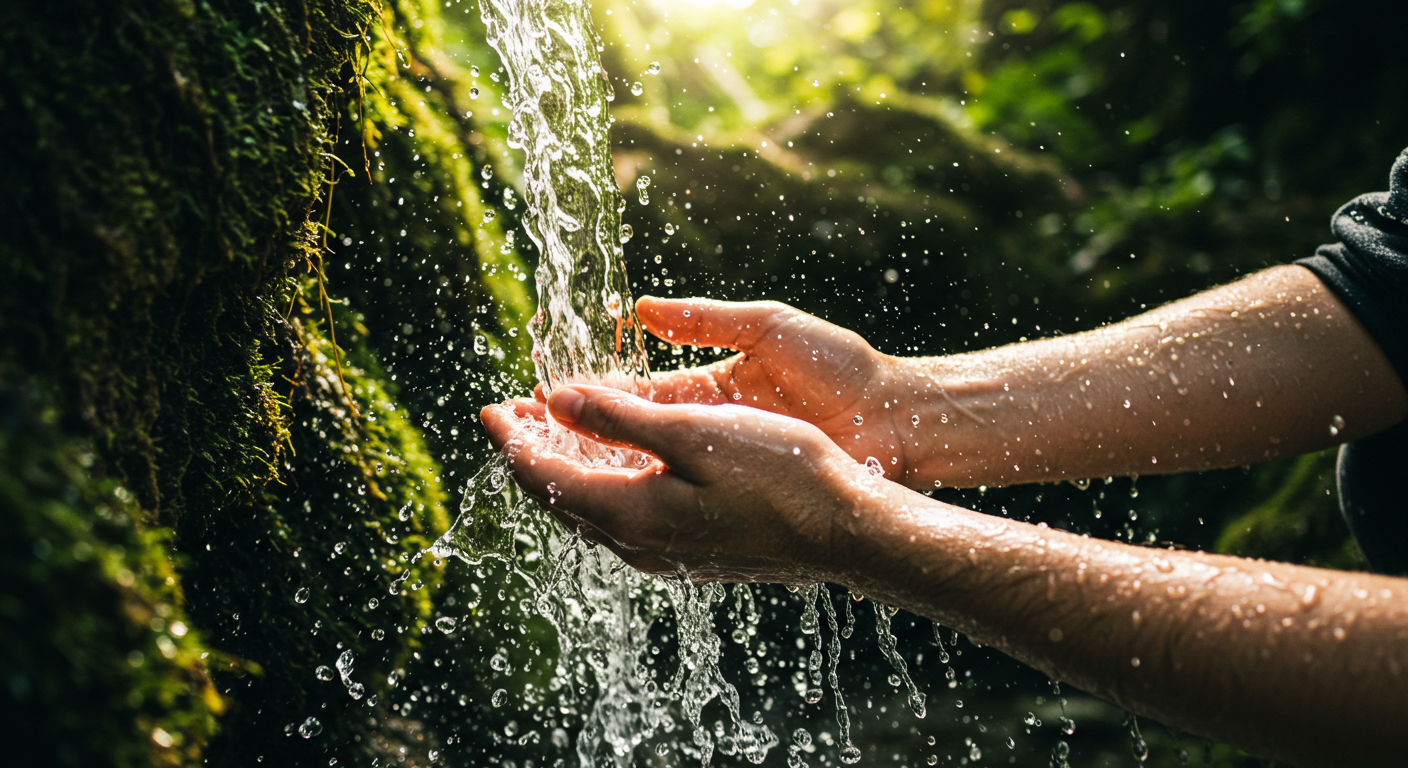

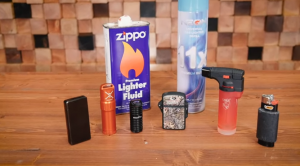
![Best Archery Sets This 2023 [Men & Women]](/assets/images/8cf78150f1d9d7a0c175609145d21517.png)
